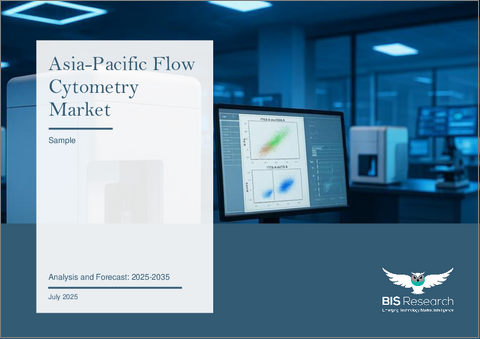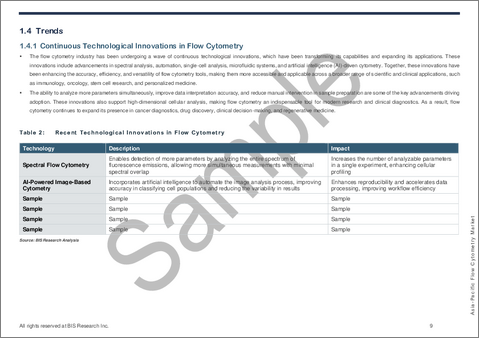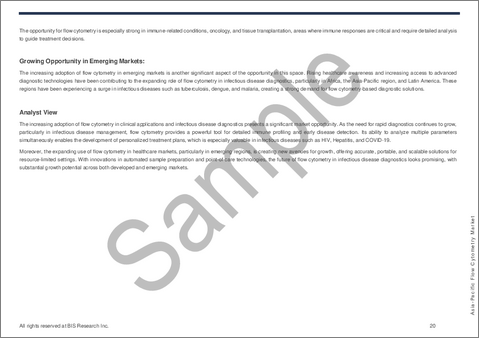|
|
市場調査レポート
商品コード
1781119
アジア太平洋地域のフローサイトメトリー市場:分析・予測 (2025-2035年)Asia-Pacific Flow Cytometry Market: Analysis and Forecast, 2025-2035 |
||||||
カスタマイズ可能
|
|||||||
| アジア太平洋地域のフローサイトメトリー市場:分析・予測 (2025-2035年) |
|
出版日: 2025年07月31日
発行: BIS Research
ページ情報: 英文 51 Pages
納期: 1~5営業日
|
全表示
- 概要
- 図表
- 目次
アジア太平洋地域のフローサイトメトリーの市場規模は、2024年の7億4,770万米ドルから、堅調な成長軌道にあり、2035年には19億1,960万米ドルに成長すると予測されています。
アジア太平洋地域では、フローサイトメトリーが重要な分析手法として注目されており、懸濁液中の個々の細胞を多項目にわたって包括的に解析することが可能になっています。この技術は、同地域の学術研究、医薬品開発、臨床診断の分野でますます重要性を増しています。がん研究、免疫学、感染症研究においては、イムノフェノタイピング、細胞周期解析、バイオマーカー検出といった主要な応用が頻繁に用いられています。
| 主要市場統計 | |
|---|---|
| 予測期間 | 2025-2035年 |
| 2025年評価 | 8億810万米ドル |
| 2035年予測 | 19億1,960万米ドル |
| CAGR | 9.04% |
同市場の急速な拡大は、特に韓国、日本、中国、インドといった国々において、スペクトルフローサイトメトリーやハイスループット技術の利用が進んでいることによって促進されています。試薬技術やデータ解析システムの進歩により、精度や運用効率もさらに向上しています。また、精密診断、細胞・遺伝子治療、個別化医療への関心の高まりも需要を加速させています。
フローサイトメトリーは、先進国・新興国の双方で医療インフラが強化される中で、トランスレーショナルリサーチや標的治療の計画に不可欠なツールとなりつつあります。同地域における精密医療やライフサイエンスのエコシステムが発展するにつれ、その重要性はますます高まり、不可欠な促進要素としての地位を築いています。
地域区分:
アジア太平洋
- 中国
- 日本
- インド
- 韓国
- オーストラリア
- タイ
- シンガポール
- その他
当レポートでは、アジア太平洋地域のフローサイトメトリーの市場を調査し、主要動向、市場影響因子の分析、法規制環境、技術・特許の分析、市場規模の推移・予測、各種区分・地域/主要国別の詳細分析、競合情勢、主要企業のプロファイルなどをまとめています。
目次
エグゼクティブサマリー
範囲と定義
第1章 市場:業界展望
- フローサイトメトリー市場:市場規模
- 概要
- 主な調査結果
- 規制状況/コンプライアンス
- 日本
- 市場力学
- 動向、促進要因、課題、機会:現状と将来の影響評価
- 動向
- フローサイトメトリーにおける継続的な技術革新
- フローサイトメトリー企業間のコラボレーション、戦略的パートナーシップ、アライアンスの増加
- 市場力学
- 市場促進要因
- 市場抑制要因
- 市場機会
第2章 地域
- 地域サマリー
第3章 市場:競合ベンチマーキングと企業プロファイル
- 企業別製品ベンチマーク
- 競合情勢
- 企業プロファイル
- Sysmex Corporation
第4章 調査手法
List of Figures
- Figure 1: Asia-Pacific Flow Cytometry Market (by Scenario), $Million, 2025 2030, and 2035
- Figure 2: Market Snapshot, 2024
- Figure 3: Asia-Pacific Flow Cytometry Market, Market Size ($Million), 2024-2035
- Figure 4: Incidence of Cancer (by Region), Million, 2022, 2025, 2030, 2040, and 2050
- Figure 5: Key Drivers for Flow Cytometry's Role in Regenerative Medicine:
- Figure 6: Healthcare R&D Spending, $Billion, 2020-2023
- Figure 7: Key Applications in Infectious Disease Diagnostics
- Figure 8: Asia-Pacific Flow Cytometry Market, $Million, 2024-2035
- Figure 9: China Flow Cytometry Market, $Million, 2024-2035
- Figure 10: Japan Flow Cytometry Market, $Million, 2024-2035
- Figure 11: India Flow Cytometry Market, $Million, 2024-2035
- Figure 12: South Korea Flow Cytometry Market, $Million, 2024-2035
- Figure 13: Australia Flow Cytometry Market, $Million, 2024-2035
- Figure 14: Thailand Flow Cytometry Market, $Million, 2024-2035
- Figure 15: Singapore Flow Cytometry Market, $Million, 2024-2035
- Figure 16: Rest of Asia-Pacific Flow Cytometry Market, $Million, 2024-2035
- Figure 17: Flow Cytometry Market, Product Benchmarking (by Company)
- Figure 18: Share of Key Strategies and Developments in Flow Cytometry Market, January 2020-May 2025
- Figure 19: Data Triangulation
- Figure 20: Top-Down and Bottom-Up Approach
- Figure 21: Assumptions and Limitations
List of Tables
- Table 1: Market Snapshot
- Table 2: Recent Technological Innovations in Flow Cytometry
- Table 3: Recent Strategic Activities Among Flow Cytometry Players
- Table 4: Flow Cytometry Instruments and Reagents in Regenerative Medicine
- Table 5: Price Comparison of Flow Cytometers
- Table 6: Flow Cytometry Market (by Region), $Million, 2024-2035
- Table 7: Asia-Pacific Flow Cytometry Market (by Country), $Million, 2024-2035
This report can be delivered in 2 working days.
Introduction to Asia-Pacific Flow Cytometry Market
The Asia-Pacific flow cytometry market, valued at $747.7 million in 2024, is on a robust growth trajectory and is anticipated to reach $1,919.6 million by 2035. In the APAC region, flow cytometry has emerged as a significant analytical method, allowing for complete multiparametric examination of individual cells in suspension. It is becoming more and more significant in academic research, pharmaceutical development, and clinical diagnostics throughout the region. In oncology, immunology, and infectious disease research, key applications like immunophenotyping, cell cycle analysis, and biomarker detection are frequently employed.
| KEY MARKET STATISTICS | |
|---|---|
| Forecast Period | 2025 - 2035 |
| 2025 Evaluation | $808.1 Million |
| 2035 Forecast | $1,919.6 Million |
| CAGR | 9.04% |
Rapid market expansion is being facilitated by the increasing use of spectral flow cytometry and high-throughput technologies, especially in nations like South Korea, Japan, China, and India. Accuracy and operating efficiency are being further improved by developments in reagent technologies and data analysis systems. Demand is also being accelerated by the growing emphasis on precision diagnostics, cell and gene treatments, and personalized medicine.
Flow cytometry is becoming an essential tool for translational research and targeted treatment planning as the healthcare infrastructure in both developed and emerging APAC markets gets stronger. As the region's precision medicine and life sciences ecosystem develops, its growing importance places it as a crucial facilitator.
Market Introduction
The market for APAC flow cytometry (FCM) is expanding rapidly due to rising demand in biomedical research, clinical diagnostics, and biopharmaceutical production. Flow cytometry is frequently used in cell cycle research, immunophenotyping, and biomarker development because it allows for quick, high-resolution study of individual cells. Research on autoimmune disorders, infectious diseases, and oncology is using it more and more in the area.
Technological developments including spectral flow cytometry, high-throughput, compact devices, and AI-based data interpretation tools are propelling the industry. Adoption is increasing in nations like China, India, Japan, and South Korea as a result of escalating research funding, benevolent government policies, and growing healthcare demands. Additionally, flow cytometry is becoming more popular in cutting-edge fields including vaccine development, regenerative medicine, and precision medicine.
Continuous advancements in laboratory capacity and healthcare accessibility are assisting in the removal of obstacles including high equipment costs, a shortage of qualified personnel, and infrastructure gaps that still exist in some emerging economies. Furthermore, partnerships between commercial companies and academic institutions are speeding up market penetration and innovation. The market for APAC flow cytometry is expected to continue growing and changing over the next several years due to an increase in the prevalence of disease and a greater emphasis on sophisticated diagnostics.
Regional Segmentation
Asia-Pacific
- China
- Japan
- India
- South Korea
- Australia
- Thailand
- Singapore
- Rest-of-Asia-Pacific
APAC Flow Cytometry Market Trends, Drivers and Challenges
Market Trends
- Growing adoption of spectral flow cytometry and high-throughput systems for complex cell analysis
- Rising integration of AI and machine learning in data interpretation and automation
- Expanding use in precision medicine, immunotherapy, and regenerative medicine
- Miniaturization and development of portable flow cytometers for point-of-care applications
- Increasing collaborations between academic institutions and biotech firms
Key Market Drivers
- Rapid expansion of healthcare infrastructure across emerging economies (India, Southeast Asia)
- Rising incidence of chronic diseases, infectious diseases, and cancer driving demand for advanced diagnostics
- Increased government and private investment in life sciences research and biopharma manufacturing
- Growing focus on personalized medicine and cell-based research
- Favorable regulatory reforms and initiatives promoting advanced diagnostic tools
Major Challenges
- High capital and operational costs of flow cytometry instruments and reagents
- Shortage of trained personnel to operate complex systems and interpret data
- Variability in regulatory standards across APAC countries affecting device approvals
- Limited awareness and adoption in some low- and middle-income regions
- Data management complexity due to large volumes of multiparametric output
How can this report add value to an organization?
Product/Innovation Strategy: The APAC flow cytometry market analysis provides insights into evolving research and clinical needs, enabling organizations to develop customized flow cytometry instruments, reagents, and software solutions that address specific requirements such as high-parameter analysis, spectral capabilities, or streamlined workflows for clinical diagnostics.
Growth/Marketing Strategy: The report helps organizations implement targeted marketing strategies tailored to key segments such as academic research, immuno-oncology, or infectious disease diagnostics and specific regional opportunities, improving customer engagement and accelerating adoption.
Competitive Strategy: Organizations can differentiate their flow cytometry offerings by emphasizing features particularly valued by end-users in target regions, such as instrument scalability, ease of use, reagent compatibility, after-sales support, or specialized applications like cell therapy or immunophenotyping.
Table of Contents
Executive Summary
Scope and Definition
1 Market: Industry Outlook
- 1.1 Flow Cytometry Market, Market Size (US$), 2024-2035
- 1.1.1 Overview
- 1.1.2 Key Findings
- 1.2 Regulatory Landscape/Compliance
- 1.2.1 Japan
- 1.3 Market Dynamics
- 1.3.1 Trends, Drivers, Challenges, and Opportunities: Current and Future Impact Assessment, 2024-2035
- 1.4 Trends
- 1.4.1 Continuous Technological Innovations in Flow Cytometry
- 1.4.2 Increasing Collaborations, Strategic Partnerships, and Alliances among Flow Cytometry Players
- 1.5 Market Dynamics
- 1.5.1 Market Drivers
- 1.5.1.1 Rising Cancer Prevalence and the Growing Demand for Advanced Diagnostic Testing
- 1.5.1.2 Growing Use of Flow Cytometry in Regenerative Medicine
- 1.5.1.3 Growing Healthcare R&D Spending Fuels Adoption of Flow Cytometry Technologies
- 1.5.2 Market Restraints
- 1.5.2.1 High Cost of Acquisition
- 1.5.3 Market Opportunities
- 1.5.3.1 Increased Use in Clinical Applications and Infectious Disease Diagnostics
- 1.5.1 Market Drivers
2 Region
- 2.1 Regional Summary
- 2.1.1 Asia-Pacific
- 2.1.1.1 Regional Overview
- 2.1.1.2 Driving Factors for Market Growth
- 2.1.1.3 Factors Challenging the Market
- 2.1.1.4 By Country
- 2.1.1.5 China
- 2.1.1.6 Japan
- 2.1.1.7 India
- 2.1.1.8 South Korea
- 2.1.1.9 Australia
- 2.1.1.10 Thailand
- 2.1.1.11 Singapore
- 2.1.1.12 Rest-of-the-Asia-Pacific
- 2.1.1 Asia-Pacific
3 Markets - Competitive Benchmarking & Company Profiles
- 3.1 Product Benchmarking By Company
- 3.2 Competitive Landscape
- 3.2.1 Key Strategies and Developments by Company
- 3.3 Company Profiles
- 3.3.1 Sysmex Corporation
- 3.3.1.1 Overview
- 3.3.1.2 Top Products/Product Portfolio
- 3.3.1.3 Top Competitors
- 3.3.1.4 Key Strategic Developments
- 3.3.1.5 Analyst View
- 3.3.1.6 Financial Analysis
- 3.3.1 Sysmex Corporation
4 Research Methodology
- 4.1 Data Sources
- 4.1.1 Primary Data Sources
- 4.1.2 Secondary Data Sources
- 4.1.3 Data Triangulation
- 4.2 Market Estimation and Forecast





